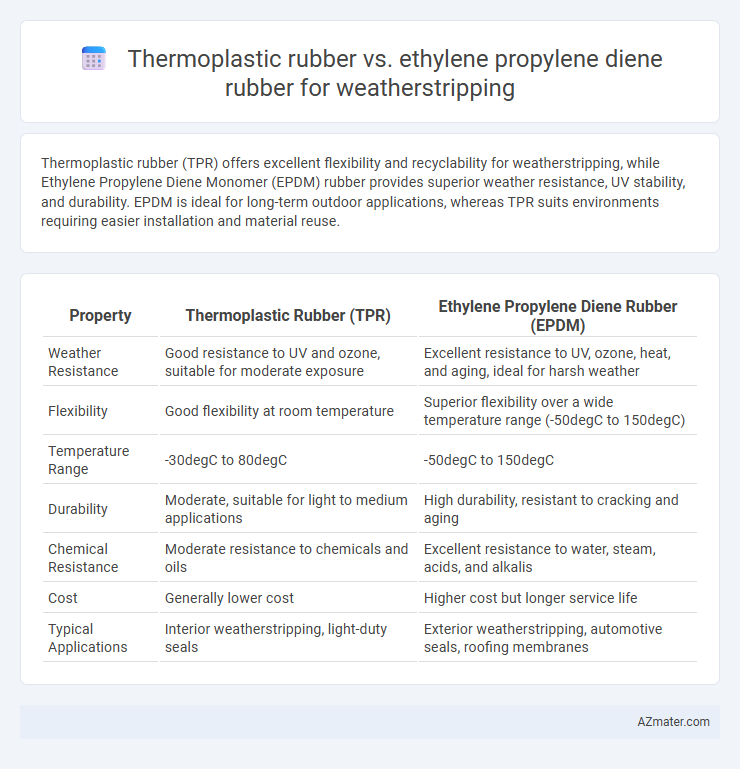Thermoplastic rubber (TPR) offers excellent flexibility and recyclability for weatherstripping, while Ethylene Propylene Diene Monomer (EPDM) rubber provides superior weather resistance, UV stability, and durability. EPDM is ideal for long-term outdoor applications, whereas TPR suits environments requiring easier installation and material reuse.
Table of Comparison
| Property | Thermoplastic Rubber (TPR) | Ethylene Propylene Diene Rubber (EPDM) |
|---|---|---|
| Weather Resistance | Good resistance to UV and ozone, suitable for moderate exposure | Excellent resistance to UV, ozone, heat, and aging, ideal for harsh weather |
| Flexibility | Good flexibility at room temperature | Superior flexibility over a wide temperature range (-50degC to 150degC) |
| Temperature Range | -30degC to 80degC | -50degC to 150degC |
| Durability | Moderate, suitable for light to medium applications | High durability, resistant to cracking and aging |
| Chemical Resistance | Moderate resistance to chemicals and oils | Excellent resistance to water, steam, acids, and alkalis |
| Cost | Generally lower cost | Higher cost but longer service life |
| Typical Applications | Interior weatherstripping, light-duty seals | Exterior weatherstripping, automotive seals, roofing membranes |
Introduction to Weatherstripping Materials
Thermoplastic rubber (TPR) offers excellent flexibility and UV resistance, making it ideal for weatherstripping applications requiring durability and easy installation. Ethylene propylene diene rubber (EPDM) provides superior resistance to ozone, heat, and weathering, ensuring long-lasting sealing performance in exterior environments. Both materials are commonly used in automotive and construction weatherstripping, with EPDM favored for extreme weather conditions and TPR preferred for cost-effective, versatile applications.
Overview of Thermoplastic Rubber (TPR)
Thermoplastic rubber (TPR) is a versatile elastomer combining the elasticity of rubber with the processability of plastics, making it ideal for weatherstripping applications due to its excellent flexibility, durability, and resistance to abrasion. TPR offers superior resilience against UV rays, ozone, and extreme temperatures, ensuring long-lasting sealing performance in automotive and architectural settings. Its ability to be melted and reshaped without losing its physical properties provides manufacturing efficiency advantages over traditional ethylene propylene diene monomer (EPDM) rubber.
Overview of Ethylene Propylene Diene Rubber (EPDM)
Ethylene Propylene Diene Rubber (EPDM) is a synthetic elastomer known for its exceptional resistance to heat, ozone, and weathering, making it ideal for weatherstripping applications. Its molecular structure provides excellent flexibility and durability in extreme temperatures ranging from -40degC to 125degC, outperforming many thermoplastic rubbers. EPDM's superior sealing properties and resistance to UV radiation ensure long-lasting protection against moisture, dust, and air infiltration in automotive and building weatherstripping products.
Key Physical and Chemical Properties
Thermoplastic rubber (TPR) offers excellent flexibility, high abrasion resistance, and good chemical stability, making it ideal for weatherstripping applications requiring easy molding and recyclability. Ethylene propylene diene rubber (EPDM) provides superior resistance to ozone, UV rays, and extreme temperatures due to its saturated polymer backbone and unsaturation in the diene monomer, ensuring long-lasting weather durability. EPDM typically exhibits better elasticity and weather resistance, while TPR excels in processability and recyclability for cost-effective weatherstripping solutions.
Weather Resistance and Durability Comparison
Thermoplastic rubber (TPR) exhibits excellent weather resistance with strong resistance to UV rays, ozone, and moisture, making it highly suitable for weatherstripping applications exposed to varying environmental conditions. Ethylene propylene diene monomer (EPDM) rubber also offers superior weather resistance, particularly excelling in extreme temperatures, ozone resistance, and aging properties, which ensures long-term durability in outdoor settings. Comparing durability, EPDM typically outperforms TPR in maintaining flexibility and structural integrity under prolonged exposure to harsh weather, while TPR provides easier processing and recyclability.
Flexibility and Elasticity Performance
Thermoplastic rubber (TPR) exhibits superior flexibility and elasticity, allowing it to return to its original shape after deformation, which is ideal for weatherstripping applications requiring frequent compression and release. Ethylene propylene diene rubber (EPDM) offers excellent elasticity with high resistance to UV rays, ozone, and extreme temperatures, ensuring long-lasting flexibility in outdoor environments. While TPR provides easier manufacturing and recyclability, EPDM's enhanced elastic performance under harsh weather conditions makes it a preferred choice for durable weatherstripping solutions.
Cost-Effectiveness and Material Lifespan
Thermoplastic rubber (TPR) offers superior cost-effectiveness for weatherstripping due to its lower manufacturing expenses and ease of recycling compared to Ethylene Propylene Diene Monomer (EPDM) rubber. EPDM provides an extended material lifespan with excellent resistance to UV rays, ozone, and extreme temperatures, making it ideal for long-term outdoor applications. While TPR suits budget-conscious projects requiring moderate durability, EPDM's robust weather resistance justifies higher upfront costs through prolonged service life.
Ease of Installation and Maintenance
Thermoplastic rubber (TPR) offers superior ease of installation for weatherstripping due to its flexibility and ability to be heat-sealed or mechanically fastened without special adhesives. Ethylene propylene diene rubber (EPDM) requires careful application with adhesives to ensure proper sealing, making installation more labor-intensive. Maintenance of TPR weatherstripping is generally simpler, as it resists cracking and does not degrade easily under UV exposure, while EPDM requires periodic inspection for potential cracking or hardening over time.
Environmental Impact and Sustainability
Thermoplastic rubber (TPR) offers enhanced recyclability compared to Ethylene Propylene Diene Monomer (EPDM) rubber, which is traditionally less eco-friendly due to its vulcanized structure that hinders recycling processes. EPDM provides excellent weather resistance and durability, reducing the frequency of replacement and thus lowering long-term environmental impact despite challenges in end-of-life disposal. Sustainable choices in weatherstripping prioritize materials like TPR for circular economy benefits, while EPDM's longevity supports resource efficiency through extended product life cycles.
Best Applications: Choosing TPR or EPDM for Weatherstripping
Thermoplastic rubber (TPR) excels in flexible, durable weatherstripping for automotive and residential doors due to its excellent elasticity and ease of molding. Ethylene propylene diene monomer (EPDM) offers superior resistance to UV rays, ozone, and extreme temperatures, making it ideal for outdoor, long-term weatherstripping applications. Selecting EPDM is best for UV exposure and harsh climates, while TPR benefits indoor or less extreme environments requiring flexibility and ease of installation.

Infographic: Thermoplastic rubber vs Ethylene propylene diene rubber for Weatherstripping
 azmater.com
azmater.com